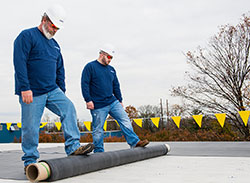|
In this day and age, the selection of any roofing system is influenced by energy efficiency, environmental attributes, and long-term sustainability. However, factors such as a building’s design, location, and climatic conditions are often overlooked during the selection process. And despite good intentions, programs like the U.S. Environmental Protection Agency’s ENERGY STAR® can contribute to confusion regarding proper roof system selection.
The ENERGY STAR label has been applied to various white roofing membranes — including TPO, PVC, and EPDM — because white membranes can help reduce air conditioning costs through solar reflectance. While this reflectance may pay dividends in hot, southern climates, a white roofing system can actually increase total energy usage in cooler, northern climates where heating costs are generally three to five times greater than cooling costs. The heating penalty of a white roof in central and northern climates is not disclosed on the ENERGY STAR label.
 |
|
|
An often-overlooked caveat on ENERGY STAR’s website cautions, “before selecting a roofing product based on expected energy savings, consumers should explore the expected calculated results that can be found on the Department of Energy's ‘Roof Savings Calculator,’” and “please remember the energy savings that can be achieved with reflective roofing are highly dependent on facility design, insulation used, climatic conditions, building location, and building envelope efficiency.”
Nevertheless, ENERGY STAR labels are placed on reflective roofing membrane used in both southern and northern climates, creating the perception that a white membrane equals energy efficiency, regardless of where it is used. The additional heating burden that white roofs can place on buildings in central and northern climates increases heating costs and adversely impacts the environment through increased consumption of natural resources.
As a leader in the commercial roofing industry and the largest manufacturer of both white and black roofing membranes, Carlisle SynTec Systems continues to recommend basing roof system selection on a building’s design, location, and climatic conditions. By being informed, you can avoid costly mistakes from a “one-size-fits-all” labeling program. For more information, please contact Ron Goodman at ron.goodman@syntec.carlisle.com.
|
